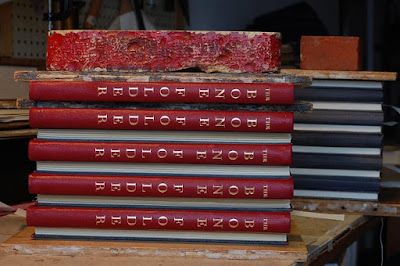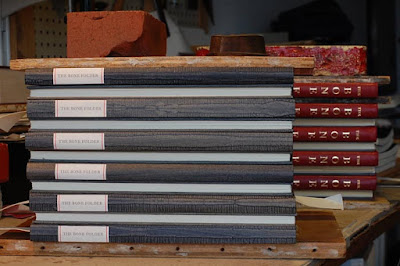My new copy of the Heftlade also had ads bound in at the back. Among them, for Ernst Collin's Corvinus-Antiquariat and for the Euphorion Verlag that published the Pressbengel. It was interesting to see that Collin was also seeking books on Free Masonry. Was he also a Mason? See also another add for his Antiquariat in the catalog for the Ausstellung handwerklicher Einbandkunst im Museum des Güstrower Kunst- und Altertumsvereins: 21. Sept. bis 15. Okt. 1924, halfway down the page here. Here's a view of Mommsenstraße 27 via Google Maps
Der Euphorion Verlag in dem der Collins Pressbengel erschien hatte zwei Inserate auf dieser Seite. Der untere ist interessant weil der Pressbengel als Band V in einer Serie von "Essays zur Pflege und Erneuerung Moderne Buchkunst" erscheint. In dem Pressbengel selbst sind zu dieser Serie keine Hinweise zu finden... Auch interessant ist das die 30 Exemplare der Luxus-Ausgabe in Leder oder Pergament erworben konnten. Ob dieser aus der Sammlung Max Hettler einer davon ist? Dort steht, daß der Einband von Hübel und Denck ist – Collin schrieb mehrer Aufsätze für deren Festschrift Fünfzig Jahre deutscher Verlegereinband, Festschrift Hübel u. Denck, Leipzig, 1875 - 1925 und den Monatsblätter für Bucheinbände und Handbindekunst.
The Euphorion Verlag, publisher of Collin's Pressbengel translated by me as The Bone Folder, had two ads on this page. The top indicated that it was looking to buy back all out-of-print titles it published and asking for offers (and prices). At bottom, an ad for the Pressbengel, indicating it as vol 5 in a series of essays on the topic of the care and handling of modern book art. There is also a description of the deluxe edition of 30 copies that could be ordered in either full-leather or parchment. Could this one from the Max Hettler collection be one of these? There, it is stated that the binding was by Hübel und Denck – Collin wrote numerous articles for their Festschrift Fünfzig Jahre deutscher Verlegereinband, Festschrift Hübel u. Denck, Leipzig, 1875 - 1925 and the monthly Monatsblätter für Bucheinbände und Handbindekunst.
Unten die Preisangaben für den Pressbengel. Leder oder Pergament für Mark 85, Pappband für Mark 4,50. Dies war während der Inflationszeit, also war Rechnen angesagt da man mit Notgeld zahlte (siehe unten). Eine Webseite die historische Währungen umrechnet kalkulierte, daß 85 Mark (1922) einen Kaufwert von $3931.93 heutigen Dollar haben könnten, 4.50 Mark den von $208.16. Ob das stimmt?
Below the pricing for the Pressbengel, leather or parchment for 85 Marks, paper for 4.50 Marks. This was during the period of hyper-inflation so need to do some real math as hyperinflation currency was printed at ever greater denominations (see below). A website that converts historical currency values calculated that 85 Mark (1922) has a value of $3931.93 current dollars, and 4.50 Mark (1922) $208.16 current dollars. Can that be right?
Wie viele Scheine von diesem Notgeld wären 1923 benötigt gewesen?
How many of these bills of Notgeld (Hyperinflation currency) would have been needed in 1923?














